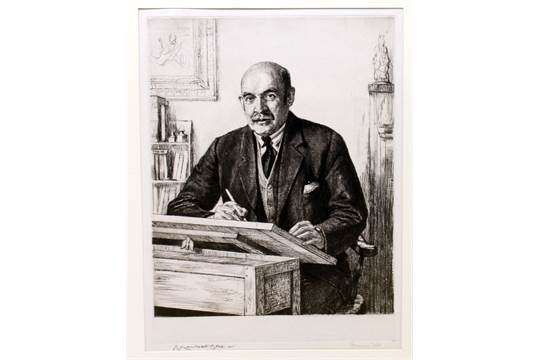
Portrait of Sir David Muirhead Bone in his studio
Framed (ref: 9359)
Signed by both Dodd & Bone in pencil
Tags: Francis Dodd etching pencil

Tags: Francis Dodd etching pencil
Provenance: The Artist's Estate; Private collection
Dodd belongs to the second generation of the Etching Revival artists a movement, which arose in the second half of the nineteenth century, sought to bring original prints back into fashion. Rembrandt was considered the great model, on account of his mastery of the technique, but also his experiments with different papers and inking. After initially working mainly as a painter, Dodd made his first drypoint in 1898, although his print production only truly began in 1907. The artist went on to use this technique regularly: it consists of cutting lines directly in the matrix with a sharp point. This spontaneous manner enabled him to make these very free portraits, especially because Dodd often finished his prints by working directly on the plate after the model.
Drypoint technique allows only a limited number of impressions, due to the rapid wear of the narrow, shallow grooves incised in the metal, under the pressure of the passages under the press.Dodd made the best use of the rough burr – particles of metal deposited along the groove that retain the ink, characteristic of the passage of the drypoint – to suggest the texture.
Dodd was born in Holyhead, Anglesey, Wales, the son of a Wesleyan minister. He trained at the Glasgow School of Art alongside Muirhead Bone, who married Dodd's sister Gertrude Helena Dodd. At Glasgow, Dodd won the Haldane Scholarship in 1893 and then travelled around France, Italy and later Spain. Dodd returned to England in 1895 and settled in Manchester, becoming friends with Charles Holden, before moving to Blackheath in London in 1904.
During World War I, in 1916, he was appointed an official war artist by Charles Masterman, the head of the War Propaganda Bureau, WPB. Serving on the Western Front, he produced more than 30 portraits of senior military figures. However, he also earned a considerable peacetime reputation for the quality of his watercolours and portrait commissions. He was appointed a trustee of the Tate Gallery in 1929, a position he held for six years, and was elected as an Associate of the Royal Academy in 1927 and a full Member in 1935.